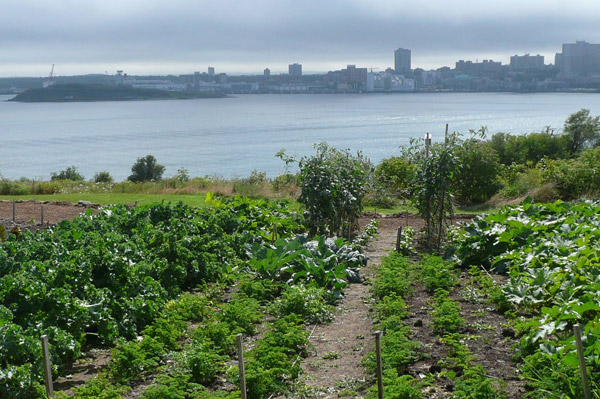
For the second year in a row I have been working with Fiskars Project Orange Thumb® as a member of their editorial board. Project Orange Thumb® gives a financial lending hand to educational, therapeutic, and community gardens in the US and Canada, and this year 30 gardens were each awarded $3,500 in cash and tools.
My role as a member of the editorial board is to assess applications and help select the 30 gardens that will receive the grant. Choosing winners is never an easy task as there are a growing number of community groups, schools, and facilities in North America that are turning on to the idea of a communal garden space as a way to engage with their communities as well as provide good food and nourishment, support, emotional well being, environmental learning, and fun. These are exiting times! The second portion of my assignment as a board member is to follow up late in the summer with a group of my choosing to see what they’ve been up to and how their garden has grown since the spring.
More and more I am becoming interested in the therapeutic and emotional impact that gardening can have on us, so with that in mind I chose to connect with the Back to Our Roots Farm, a community and market garden that operates on the grounds of The Nova Scotia Hospital in Dartmouth, Nova Scotia, Canada. Hospitals are meant to be a place of healing, and operating a garden that provides fresh food as well as a place of respite for both patients and staff just makes sense.
I spoke with coordinator Hillary Lindsay to find out more about this unfolding growing project that is currently in its second year.
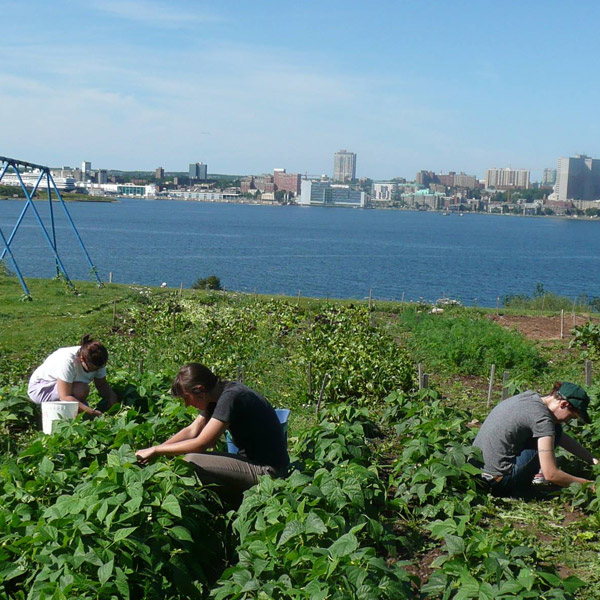
Harvesting bush beans for the weekly market stand.
My Interview with Hillary Lindsay of Back To Our Roots Urban Farm
Q: Can you tell me a little about the background of this project? What is the purpose and/or mandate of the project? Is is about being a vehicle for healing, community outreach, both?
The Urban Farm is the second one started by Partners for Care, which is the charity arm of the Nova Scotia Health Authority. The farms promote health in all its forms, environmental health, community health, physical health and mental health. Back To Our Roots is especially focused on mental health as we are on the land of the Nova Scotia Hospital, which is a mental health and addictions hospital. The gardens are a healing and calming space, a chance to be outside, have one’s hands in the soil, watching things grow; these all contribute to one’s mental health.
Q: Who participates in growing the garden and how does it work? i.e. is it set up as plots that are managed by individuals or is it one garden that all members assist in growing and maintaining collectively? How do you decide who participates?
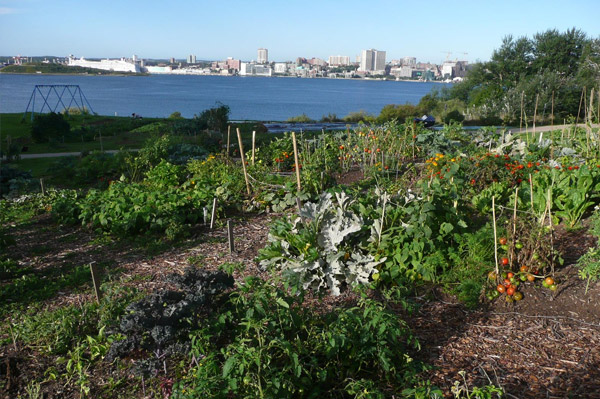
There are 3 main aspects of the farm: There are community plots where individuals and groups rent (or are donated) a plot for the season to grow food for themselves and their family (or whoever). Each of the units also has a plot, where patients garden, and harvest food for snacks or food programming within the hospital.
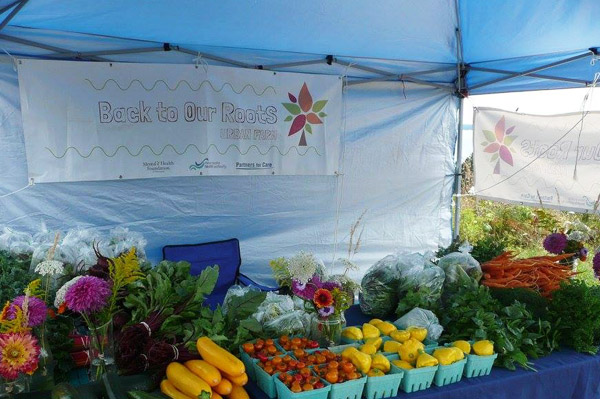
The Back to Our Roots Farm Stand in mid-summer
The Market Garden is 60 plots that are 3 feet by 20 feet. I don’t have all of that in production right now, some is just for green manure (about 12 plots). It is mostly managed by me and 5 volunteers (sometimes with help from patients as well). We grow food and flowers for an on-site pop-up market stand (on Thursdays from 3:30pm to 5pm). Bouquets and produce also go into the hospital for snacks and food programming, bringing some of the gardens vitality into the hospital setting.
The final area is The Commons. These plots are for snacking, education and experimenting. Anyone who is walking by is welcome to taste stuff from these plots. We also have plots for education, such as a pollinator friendly garden, or a herb garden (for tasting too).
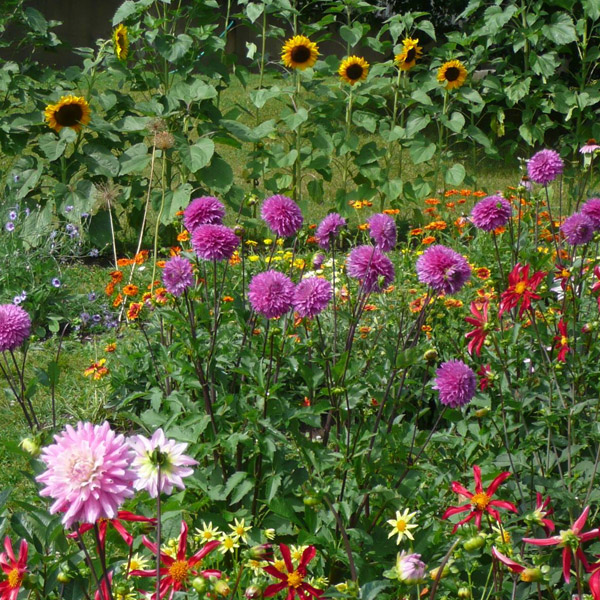
Cultivating flowers for the market stand.
Q: How do you decide who participates in the community aspect of the garden?
In terms of the community garden, it’s basically first come first serve in terms of who gets plots. Nine plots were donated, which means people who can’t afford to pay the $30 fee for the year can have them. Most of those plots are being used by new immigrants. There are 7 plots that are being used by units at the hospital (not particular patients) Three different units come out every week to work in their garden and I work with them on that. We’ve been harvesting lots from their plots recently.
This interview talks a bit about the garden and the mental health aspect.
Q: Do community members and patients interact through the garden?
Yes, it’s casual contact and I think that’s a good thing. People meet in the garden as gardeners, not as patients or community members. People like to talk about what’s growing!
Q: In the nearly 2 years you’ve been running have patients expressed any attitudes (positive or otherwise) towards the garden and the experience of gardening?
This is the first year of regular patient involvement. I hear a lot of positive feedback from the rec therapists and I certainly see people light up when they’re in the garden. It’s very exciting to see things grow, and then to get to eat what you grow! A lot of pride and wonderment. Today I harvested garlic with some of the clients from the addictions unit. They were amazed! I don’t think anyone had ever seen garlic come out of the ground before.
Q: I noticed that the garden is located on the banks of a large body of water (Halifax Harbour). Does growing that close to salt water pose any problems?
Not that I’ve been aware of. Although the wind it a bit intense!

Plowing the market garden the old school way using oxen!
Q: In researching the garden I found articles about the groundbreaking event. You had someone come in with 2 oxen and plow the plots manually as a throwback to the hospital’s history as a farm. Even if it was just a publicity draw, I LOVE this idea. Were all of the original beds plowed this way?
The market garden was done this way (not the community plots). It was pretty cool and really beautiful. I wasn’t hired yet when the decision to do this was made.
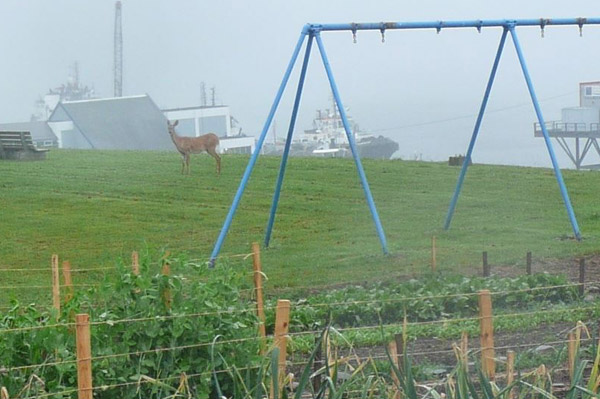
A visitor to the garden.
Q: What crops are you growing? Were they chosen for specific reasons? i.e. a need within the immediate community of participants, crops that do well in the market, etc?
Most of the crops in the market garden are the kinds of things people will already be familiar with. I wanted to grow staples that people would take home and know how to cook with. We’re growing lots of salad greens, fresh herbs (basil, parsley, dill, cilantro), peas, beans, carrots, beets, zucchini, tomatoes, kale, and chard.
Q: What challenges have you faced over the 2 seasons that the garden has been running?
Wire worm was a bit of a problem this year in areas that were newly turned over from sod. We are still looking for markets for some of our salad greens and hoping to get them into the hospital cafeteria.
Q: How did the Fiskars grant help you expand in the second season?
It’s so great to have the high quality tools from Fiskars. Last year I was working with a rake that had a head that kept falling off, and now I have these amazing, light rakes (for example) that make the garden work so much easier. We have also bought lots of great compost from Canadian Tire, and other tools and supplies we need for the garden. It’s been awesome!
Q: Now that you’re well into the second season, what direction are you planning to take going forward?
I’ve started thinking about how to start involving mental health patients in the market garden on a more regular basis. This might involve working with out-patients more or with some of the clients that are at the hospital more long term. Still not sure what this might look like, but I’ve been thinking about it!
———
To find out more about the Back to Our Roots Urban Farm you can follow them online via: Facebook
All photos in this post are courtesy of Back to Our Roots Urban Farm.
———
Disclosure: As mentioned above, I have been on the Project Orange Thumb® editorial board for the years 2015 and 2016, which is a paid position.
This is fantastic! Every hospital should do this! Thanks Gayla for telling us about this!
Great article, wish all the countries think like that to keep our planet safe in order to consume natural products.
This idea is not new. Gardening really helps people to become calmer and everybody sees that. However, why don’t we use gardening for our mental health and healing our desease? Why is this usefull project unique? It does not take too much money.
It may not be new, yet I don’t think one can take for granted that everyone knows about or understands what gardening can do for us. Especially when it comes to creating a synergy between gardening and living a healthy life. Partially, I think it’s because we have some messed up ideas in the west about the function of hospitals (and an utter lack insight about what they could be) as well as what constitutes a healthy lifestyle in the first place. It may not take much money, but it does require a massive shift in thinking.
And as for gardening, a great many people garden in a way that does not take advantage of the healing aspects of it. To the wider population gardening is sold as curb appeal and status. If that were not true than chemical fertilizers, herbicides, and other unhealthy products and practices would not be the most lucrative arm of the gardening world.
I think it all depends on people. Some of them are not ready to be gardeners. Even when they have a garden, they can work there just for supplying themselves with the food but not for health care. Most of us don’t connect health and garden. In my country most people think about the gardening as about hard work. It’s because our gradnparents worked very hard there to survive. Recently more and nore people try to enjoy this job. And it really gives them pleasure. I know one psychiatrical clinic which uses gardening as one of the healing ways.